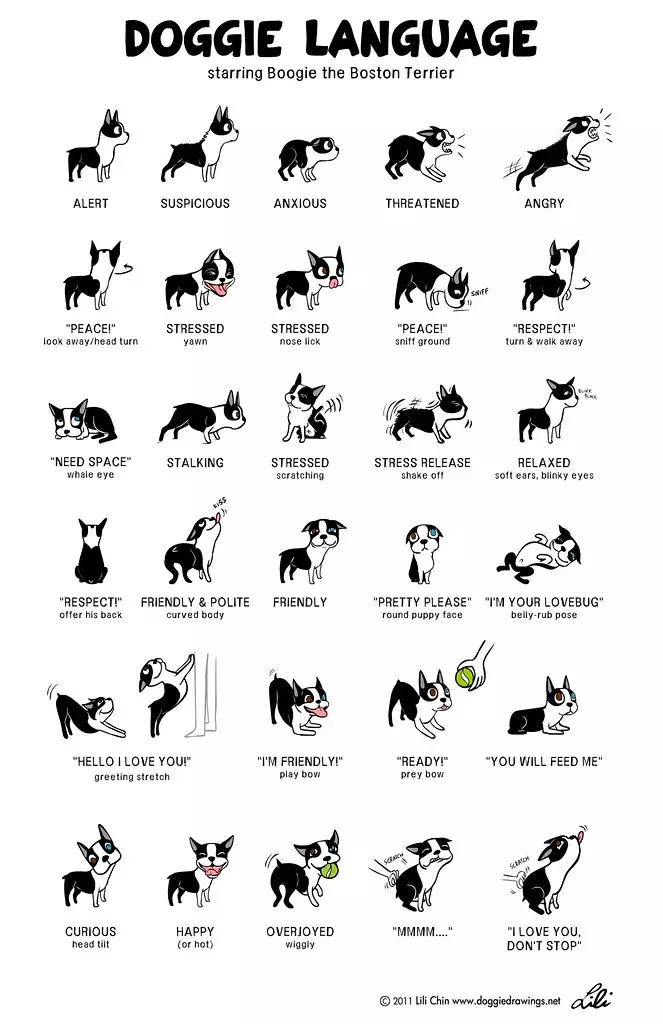Puppy Care Guide
Week 25 – Understanding Calming Signals

By week 25, your puppy’s emotional communication becomes more refined. Dogs use subtle “calming signals” — body language that expresses comfort, curiosity, or stress. Learning to read these signs deepens trust and harmony.
🐕 What Are Calming Signals?
Calming signals are non-verbal cues dogs use to express emotion or ease tension. Through posture, eyes, and movement, they communicate:
- “I’m happy.”
- “I’m nervous.”
- “Please notice me.”
- “Let’s stay calm.”
Recognizing them early allows you to respond with empathy and build safer, deeper interaction.

💬 Common Calming Signals and What They Mean
A. Raised Hips & Lowered Shoulders — Play Bow
A cheerful “Let’s play!” gesture. Appears when your dog feels safe and social. Encourage light play and avoid ending sessions abruptly to maintain balance.
💡 Tip: Transition calmly from play to rest to prevent frustration.
B. Jumping Up When You Leave
“Please don’t go!” — a sign of attachment and mild separation anxiety. Offer calm reassurance before leaving and practice short absences.
🩺 Professional Advice: Quiet exits + low-key returns teach that departures are safe.
C. Paw Tapping or Touching You
“Notice me!” — a gentle request for interaction. Respond kindly but set soft boundaries to teach patience.
🐾 Training Tip: Reward calm waiting as much as attention-seeking.
D. Pacing Back and Forth
Indicates anxiety or restlessness — check environment, noise, or bathroom needs. Offer a quiet, secure space.
🧠 Insight: Persistent pacing may reflect stress — increase routine and enrichment.
🧠 Why Recognizing Calming Signals Matters
Puppies can’t explain feelings with words — their gestures are their voice. Yawning, licking, or turning away often mean “I want peace.” Reading these cues early prevents conflict and deepens mutual understanding.
🐶 Example — Licking or Slurping
Lip-licking or gulping isn’t always thirst — it often means “I’m uneasy.” Respond calmly instead of scolding to preserve trust.
💡 Tip: Dogs mirror our emotions. Your calm energy teaches emotional stability.
🧍♀️ How to Communicate Back
Use short, consistent words — “Sit,” “Stay,” “Good.” Avoid long phrases; dogs read tone, not grammar. Observe triggers and emotions before reacting.
- Check what happened right before the signal.
- Note sounds, smells, or movements that caused it.
- Guide calmly — not by force but by clarity.
🧩 The Core of Calming Signals — Shared Empathy
True communication rests on mutual trust. When your dog feels seen and safe, their signals soften — and understanding grows.
“The more we observe, the better we understand — and the stronger the bond becomes.”
❤️ PetGo’s Gentle Care Tip
Frequent calming signals (pacing, licking, whining) show your dog self-soothing. Support them with consistent routines, quiet rest spaces, and balanced playtime. A calm dog isn’t silent — it’s one who feels safe, understood, and loved.
🐾 Reflective Moment
When you call your dog’s name and they turn with bright eyes and a wagging tail — that’s connection in its purest form.
PetGo celebrates every bond like this — helping you raise a confident, emotionally balanced, and joyful companion. 💛
Continue with PetGo’s Puppy Care Guide
PetGo helps you understand your puppy’s body language and emotions — one wag at a time.
© 2025 PetGo. All Rights Reserved
